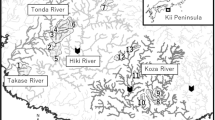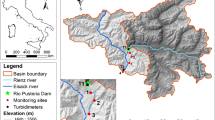Abstract
Freshwater shrimp dominate the faunal biomass of many headwater tropical streams: however, their role in community organization is unclear. Enclosure/exclosure experiments in a montane Puerto Rican stream examined direct and indirect effects of two dominant taxa of atyid (Atyidae) shrimp, Atya lanipes Holthuis and Xiphocaris elongata Guerin-Meneville. Both shrimp taxa caused significant reductions in sediment cover on rock substrata, reducing sedimentation and enhancing algal biovolume on clay tiles in cages. When tiles incubated in shrimp exclosures for 2 wks were placed outside of cages, atyid shrimp removed 100% of the sediment cover within a 30 min observation period. Atyid shrimp appear to play an important role in stream recovery after high discharge events by rapidly removing sediments and detritus deposited on benthic substrata in pools. We evaluated the mechanism by which A. lanipes influences algae and benthic insects by comparing patterns of algal biomass, taxonomic composition, and insect abundance between shrimp-exclusion and shrimp-presence treatments both with and without manual sediment removal. The shrimp exclusion treatment without manual sediment removal bad significantly lower algal biomass and greater sedimentation than all other treatments. The treatment in which shrimp were excluded but sediment was manually removed, however, accrued almost the same algal biovolume as the shrimp enclosure treatment, supporting the hypothesis that sediment removal enhances the biovolume of understory algal taxa. Algal community composition was similar between stream bottom bedrock exposed to natural densities of shrimp and all experimental treatments for both Atya and Xiphocaris: a diatom community strongly dominated (78–95%) by the adnate taxon, Achnanthes lanceolata Breb ex. Kutz. Atyid shrimp are important in determining the distribution and abundance of benthic insects through both direct and indirect effects. Sessile, retreat-building chironomid larvae (Chironomidae: Diptera) are negatively affected by both A. lanipes and X. elongata, through direct removal by foraging activities and/or indirectly through depression of sediment resources available to larvae for the construction of retreats. In constrast, the mobile grazer, Cloeodes maculipes (Baetidae: Ephemeroptera) was not adversely affected and atyid shrimp have the potential to exert positive indirect effects on this taxon by facilitating its exploitation of algal resources and/or through enhancement of understory algal food resources through sediment removal.
Similar content being viewed by others
References
Abele LG, Blum N (1977) Ecological aspects of the freshwater decapod crustaceans of the Perlas Archipelago, Panama. Biotropica 9:239–252
Allan JD (1978) Trout predation and the size composition of stream drift. Limnol Oceanogr 23:1231–1237
Angermeier PL, Karr JR (1983) Fish communities along environmental gradients in a system of tropical streams. Environ Biol Fish 9:117–135
Bell SS, Coull BC (1978) Field evidence that shrimp predation regulates meiofauna. Oecologia 35:141–148
Bhajan WR, Canals M, Colon JA, Block AM, Clements RG (1978) A limnological survey of the Rio Espiritu Santo watershed, Puerto Rico, (1976–1977). Report for the Center for Energy and Environmental Research, University of Puerto Rico, San Juan
Bowen SH (1983) Detritivory in neotropical fish communities. Environ Biol Fishes 9:137–144
Brenchley GA (1981) Disturbance and community structure: an experimental study of bioturbation in marine soft-bottom environments. J Mar Res 39:767–790
Bright GR (1982) Secondary benthic production in a tropical island stream Limnol Oceanogr 27:472–480
Brown S, Lugo AE, Silander S, Liegel L (1983) Research history and opportunities in the Luquillo Experimental Forest. Gen Tech Rep SO-44, USDA Southern Forest Experimental Station, New Orleans, LA, 128 p
Cooper SD, Walde SJ, Peckarsky BL (1990) Prey exchange rates and the impact of predators on prey populations in streams. Ecology 7:1503–1514
Covich AP (1988a) Atyid shrimp in the headwaters of the Luquillo Mountains, Puerto Rico: Filter feeding in natural and artificial streams. Verh Internat Verein Limnol 23:2108–2113
Covich AP (1988b) Geographical and historical comparisons of neotropical streams: biotic diversity and detrital processing in highly variable habitats. J North Amer Benthol Soc 7:361–386
Covich AP, Crowl TA, Johnson SL, Varza D, Gertain DL (1991) Post-hurricane Hugo increases in atyid shrimp abundances in a Puerto Rican montane stream. Biotropica 23:448–454
Dudgeon D (1985) The population dynamics of some freshwater carideans (Crustacea: Decapoda) in Hong Kong, with special reference to Neocaridina serrata (Atyidae). Hydrobiologia 120:141–149
Felgenhauer BE, Abele LG (1983) Ultrastructure and functional morphology of feeding and associated appendages in the tropical fresh-water shrimp Atya innocous (Herbst) with notes on its ecology. J Crustacean Biol 3:336–363
Felgenhauer BE, Abele LG (1985) Feeding structures of two atyid shrimps with comments on caridean phylogeny. J Crustacean Biol 5:397–419
Ferrington LC, Masteller EC, Buzby KM (1992) Composition and temporal abundance of Chironomidae emergence from a tropical rainforest stream at El Verde, Puerto Rico. J Kansas Ent Soc (in press)
Flecker AS (1992) Fish trophic guilds and the structure of a tropical stream: weak direct versus strong indirect effects. Ecology 73:927–940
Flecker AS, Allan JD (1984) The importance of predation, substrate, and spatial refugia in determining lotic insect distributions. Oecologia 64:306–313
Flint OS, Masteller EC (1992) Composition and temporal abundance of Trichoptera emergence from a tropical rainforst stream at El Verde, Puerto Rico. J Kansas Ent Soc (in press)
Frangi JL, Lugo AE (1991) Hurricane damage to a flood plain forest in the Luquillo Mountains of Puerto Rico. Biotropica 23:324–335
Gelhaus JK, Masteller EC, Buzby K (1992) Composition and temporal abundance of Tipulidae (Diptera) emergence from a tropical rainforest stream at El Verde, Puerto Rico. J Kansas Ent Soc (in press)
Gilliam JF, Fraser DF, Sabat AM (1989) Strong effects of foraging minnows on a stream benthic invertebrate community. Ecology 70:445–452
Goulding M, Carvalha ML, Ferreira EG (1988) Rio Negro: Rich life in poor water. SPB Academic Publ., The Hague, Netherlands
Gruendling GK (1971) Ecology of the epipelic algal communities in Marion Lake, British Columbia. J Phycol 7:239–249
Hart DD (1983) The importance of competitive interactions within stream populations and communities. In: Barnes JR, Minshall GW (eds) Stream ecology: Application and testing of general ecological theory. Plenum Press, New York, pp 99–136
Hemphill N, Cooper SD (1984) Differences in the community structure of pools containing or lacking trout. Verh Internat Verin Limnol 22:1858–1861
Hobbs HH, Hart CW (1982) The shrimp genus Atya (Decapoda: Atyidae). Smithsonian Contributions to Zoology No. 364:1–143
Hunter W (1978) The distribution of freshwater shrimps (Atyidae and Palaemonidae) in Jamaica. Zool J Linn Soc London 64:135–150
Kneib RT (1985) Predation and disturbance by grass shrimp, Palaemontes pugio Holtius in soft-substratum benthic invertebrate assemblages. J Exper Mar Biol Ecol 93:91–102
Kohler SL, McPeek MA (1989) Predation risk and the foraging behavior of competing stream insects. Ecology 70:1811–1825
Lamberti GA, Resh VH (1983) Stream periphyton and insect herbivores: An experimental study of grazing by a caddisfly population. Ecology 64:1124–1135
Lamberti GA, Feminella JW, Resh VH (1987a) Herbivory and intraspecific competition in a stream caddisfly population. Oecologia 73:75–81
Lamberti GA, Ashkenas LR, Gregory SV, Steinman AD (1987b) Effects of three herbivores on periphyton communities in laboratory streams. J North Am Benthol Soc 6:92–104
Loeb SL (1981) An in situ method for measuring the primary productivity and standing crop of the epilithic periphyton community in lentic systems. Limnol Oceanogr 26:394–399
Lowe-McConnell RH (1987) Ecological studies in tropical fish communities. Cambridge University Press, New York, NY
Lugo AE (1985) Water and the ecosystem of the Luquillo Experimental Forest. Technical Report 50-63, U.S.D.A. Forest Service, Southern Forest Experimental Station, New Orleans, LA
Masteller EC, Buzby KM (1992) Composition and temporal abundance of aquatic insect emergence from a tropical rainforest stream at El Verde, Puerto Rico. J Kansas Ent Soc (in press)
McAuliffe JR (1984) Resource depression by a stream herbivore: effects on distributions and abundances of ther grazers. Oikos 42:327–333
McDowell WH (1984) Water quality in rainforest streams of Puerto Rico. In: Proc. First Caribbean Islands Water Resources Congress, St. Thomas, U.S. Virgin Islands, pp 94–107
McDowell WH, Gines Sanchez C, Asbury CE, Ramos Perez CR (1990) Influence of sea salt aerosols and long range transport on precipitation chemistry at El Verde, Puerto Rico. Atmos Environ 24:2813–2821
Payne AI (1986) The ecology of tropical lakes and rivers. John Wiley New York
Pescador ML, Masteller EC, Buzby K (1992) Composition and temporal abundance of Ephemeroptera emergence from a tropical rainforest stream at El Verde, Puerto Rico. J Kansas Ent Soc (in press)
Power ME (1984a) The importance of sediment in the grazing ecology and size class interactions of an armored catfish, Ancistrus spinosus. Environ Biol Fish 10:173–181
Power ME (1984b) Habitat quality and the distribution of armored catfish in a Panamanian stream. J Anim Ecol 53:357–374
Power ME (1987) Predator avoidance by grazing fishes in temperate and tropical streams: Importance of stream depth and prey size. In: Kerfoot WC, Sih A (eds) Predation: Direct and indirect impacts on aquatic communities. University Press of New England Hanover NH, pp 333–351
Power ME (1990a) Effects of fish in river food webs. Science 250:811–814
Power ME (1990b) Resource enhancement by indirect effects of grazers: armored catfish, algae, and sediment. Ecology 71:897–904
Power ME, Matthews WJ (1983) Algae-grazing minnows (Campostoma anomalum), piscivorous bass (Micropterus spp.) and the distribution of attached algae in a small prairie-margin stream. Oecologia 60:328–332
Power ME, Matthews WJ, Stewart AJ (1985) Grazing minnows, piscivorous bass and stream algae: Dynamics of a strong interaction. Ecology 66: 1448–1556
Power ME, Dudley TL, Cooper SD (1989) Grazing catfish, fishing birds, and attached algae in a Panamanian stream. Environ Biol Fish 26:285–294
Rhoads DC (1974) Organism-sediment relations on the muddy sea floor. Mar Biol Ann Rev 12:263–300
Rhoads DC, Young DK (1970) The influence of deposit-feeding organisms on sediment stability and community trophic structure J Mar Res 28: 150–178
Rodriguez G (1980) Los crustaceos decapods de Venezuela. Inst. Venez. Invest. Cient., Caracas
Scatena FN, Larsen MC (1991) Physical aspects of Hurricane Hugo in Puerto Rico. Biotropica 23:317–323
Sih AS, Kats LB, Moore RD (1992) Effects of predatory sunfish on the density, drift and refuge use of stream salamander larvae. Ecology 73:1418–1430
Sokal RR, Rohlf FJ (1981) Biometry. Second edition. W. H. Freeman, San Francisco, CA, USA
Stander JM (1970) Diversity and similarity of benthic fauna of Oregon. Masters thesis. Oregon State University, Corvallis, Oregon
Walker LR (1991) Tree damage and recovery from Hurricane Hugo in Luquillo Experimental Forest, Puerto Rico. Biotropica 23:379–385
Woodin SA, Jackson JB (1979) Interphyletic competition among marine benthos. Amer Zool 19:1029–1043
Author information
Authors and Affiliations
Rights and permissions
About this article
Cite this article
Pringle, C.M., Blake, G.A., Covich, A.P. et al. Effects of omnivorous shrimp in a montane tropical stream: sediment removal, disturbance of sessile invertebrates and enhancement of understory algal biomass. Oecologia 93, 1–11 (1993). https://doi.org/10.1007/BF00321183
Received:
Accepted:
Issue Date:
DOI: https://doi.org/10.1007/BF00321183




